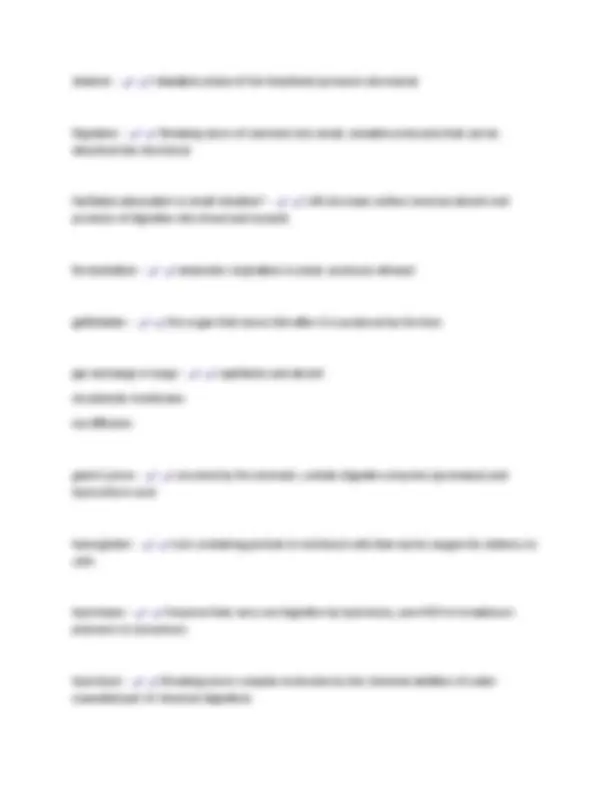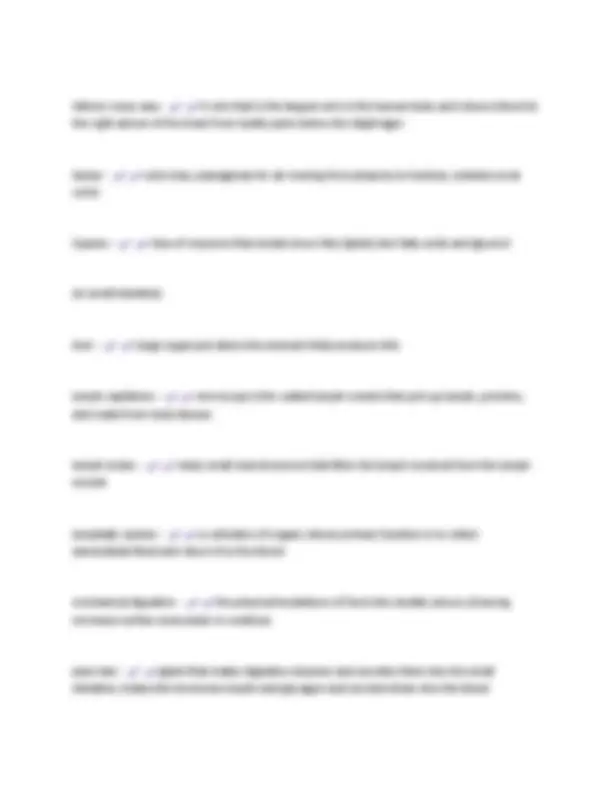






Study with the several resources on Docsity

Earn points by helping other students or get them with a premium plan


Prepare for your exams
Study with the several resources on Docsity

Earn points to download
Earn points by helping other students or get them with a premium plan
Community
Ask the community for help and clear up your study doubts
Discover the best universities in your country according to Docsity users
Free resources
Download our free guides on studying techniques, anxiety management strategies, and thesis advice from Docsity tutors
accessory organs - aerobic respiration - and storing it in ATP Liver, Gallbladder, Pancreas cellular respiration that uses oxygen, sequentially releasing energy begins in cytoplasm--ends in mitochondria alimentary canal - a long, muscular tube that begins at teh mouth and includes the mouth, pharynx, esophagus, stomcah, small intestine, large intestine, and anus alveolus - t iny air sac at the end of a bronchiole in the lungs that provides surface area for gas exchange to occur amalyse - saliva contains this enzyme; begins the process of chemical digestion by breaking down starches (carbohydrates--glucose) anaerobic respiration - produces lactic acid aorta - less efficient, produce less ATP The largest artery in the body; it conducts freshly oxygenated blood from the heart to the tissues. atrioventricular valve - A valve in the heart between each atrium and ventricle that
Typology: Exams
1 / 8

This page cannot be seen from the preview
Don't miss anything!





accessory organs - Liver, Gallbladder, Pancreas aerobic respiration - cellular respiration that uses oxygen, sequentially releasing energy and storing it in ATP begins in cytoplasm--ends in mitochondria alimentary canal - a long, muscular tube that begins at teh mouth and includes the mouth, pharynx, esophagus, stomcah, small intestine, large intestine, and anus alveolus - tiny air sac at the end of a bronchiole in the lungs that provides surface area for gas exchange to occur amalyse - saliva contains this enzyme; begins the process of chemical digestion by breaking down starches (carbohydrates--glucose) anaerobic respiration - less efficient, produce less ATP produces lactic acid aorta - The largest artery in the body; it conducts freshly oxygenated blood from the heart to the tissues.
atrioventricular valve - A valve in the heart between each atrium and ventricle that prevents a backflow of blood when the ventricles contract. bile - a digestive juice secreted by the liver and stored in the gallbladder--breaks down fats Blood - - connective tissue
diastole - relaxation phase of the heartbeat (pressure decreases) Digestion - Breaking down of nutrients into small, soluable molecules that can be absorbed into the blood facilitates absorption in small intestine? - villi (increase surface area toa absorb end products of digestion into blood and nymph) fermentation - anaerobic respiration in yeast--produces ethanol gallbladder - the organ that stores bile after it is produced by the liver gas exchange in lungs - capillaries and alveoli via avleolar membrane via diffusion gastric juices - secreted by the stomach; contain digestive enzymes (proteases) and hydrochloric acid hemoglobin - iron-containing protein in red blood cells that carries oxygen for delivery to cells hydrolases - Enzymes that carry out digestion by hydrolosis, uses H2O to breakdown polymers to monomers hydrolysis - Breaking down complex molecules by the chemical addition of water (essential part of chemical digestion)
inferior vena cava - A vein that is the largest vein in the human body and returns blood to the right atrium of the heart from bodily parts below the diaphragm. larynx - voice box; passageway for air moving from pharynx to trachea; contains vocal cords Lipases - class of enzymes that breaks down fats (lipids) into fatty acids and glycerol. (in small intestine) liver - Large organ just above the stomach that produces bile lymph capillaries - microscopic thin-walled lymph vessels that pick up lymph, proteins, and waste from body tissues lymph nodes - many small oval structures that filter the lymph received from the lymph vessels lymphatic system - a collection of organs whose primary function is to collect extracellular fluid and return it to the blood mechanical digestion - the physical breakdown of food into smaller pieces (chewing increases surface area-easier to swallow) pancreas - gland that makes digestive enzymes and secretes them into the small intestine; makes the hormones insulin and glucagon and secretes them into the blood
route of respiratory system - nasal cavaties pharynx larynx trachea bronchi lungs bronchioles alveolus semilunar valve - another name for the pulmonary and aortic valves , A valve located at the two exits of the heart, where the aorta leaves the left ventricle and the pulmonary artery leaves the right ventricle. small intestine - responsible for most chemical digestion and absorption of nutrients
a.k.a LEUKOCYTES